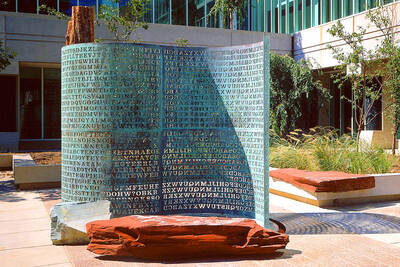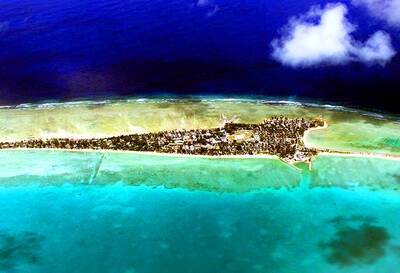A gouge on Endeavour's belly does not need to be repaired in orbit, NASA has decided after several days of testing, analysis and deliberation about the space shuttle.
The decision came on Thursday night after a five-hour meeting of mission managers. They decided against any risky spacewalk repairs based on the overwhelming -- but not unanimous -- recommendations of hundreds of engineers.
The massive amount of data the managers gathered indicated that Endeavour would suffer no serious structural damage during next week's re-entry.
For several days, NASA had said crew safety was not at risk. The concern was that the heat of re-entry could weaken the shuttle's aluminum frame at the damaged spot and result in lengthy post-flight repairs, but testing showed that would not be the case.
Ultimately, managers decided they could not justify putting spacewalking astronauts at risk if the vehicle was in acceptable shape to make the journey home.
A spacewalk earlier this week, cut short by an astronaut's ripped glove, showed how hazardous even a relatively routine jaunt outside the international space station can be.
"I am 100 percent comfortable that the work that has been done has accurately characterized it [the damage] and that we will have a very successful re-entry," said John Shannon, chairman of the mission management team.
"I am also 100 percent confident that if we would have gotten a different answer and found out that this was something that was going to endanger the lives of the crew, that we had the capability on board to go and repair it and then have a successful entry," he said.
Johnson Space Center's engineering group in Houston wanted to proceed with the repairs. But everyone else, including safety officials, voted to skip them.
The thermal shielding on Endeavour's belly was pierced by a piece of debris that broke off the external fuel tank shortly after liftoff on Aug. 8.
The debris, either foam insulation, ice or a combination of both, weighed just 10g but packed enough punch to carve out an 8cm-long, 5cm-wide gouge and dig all the way through the thermal tiles.
Left completely exposed was a narrow 2.5cm strip of the overlying felt fabric, the last barrier before the shuttle's aluminum structure.
The only way to fix the gouge would have been to send a pair of spacewalkers out with black protective paint and caulk-like goo, and maneuver them beneath the shuttle on the end of a 30m robotic arm and extension boom, with few if any close-up camera views of the work.
The shuttle's crew had spent much of Thursday running through the never-before-attempted repair methods, just in case they were ordered.
Crew members were informed of the decision not to make repairs before they went to sleep on Thursday.
However, a Nobel Prize-winning physicist who served on the Columbia investigation board four years ago, Stanford University's Douglas Osheroff, questioned NASA's hesitancy to perform the repairs since it "can only increase their chances of making it down."
I don't see why NASA is going to invent a fix and not use it," Osheroff said before Thursday night's decision.
"This attitude of, `It looks like it's OK, let's not do anything about it,' it seems like the Columbia NASA," he said.
The Endeavour crew is more than halfway through its two-week mission to the space station.
It has successfully completed its main tasks, including attaching a new truss segment to the station, replacing a gyroscope that helps control the station's orientation and preparing a solar array for relocation to another spot on the orbiting outpost -- a task that will be undertaken on a later mission.

DISASTER: The Bangladesh Meteorological Department recorded a magnitude 5.7 and tremors reached as far as Kolkata, India, more than 300km away from the epicenter A powerful earthquake struck Bangladesh yesterday outside the crowded capital, Dhaka, killing at least five people and injuring about a hundred, the government said. The magnitude 5.5 quake struck at 10:38am near Narsingdi, Bangladesh, about 33km from Dhaka, the US Geological Survey (USGS) said. The earthquake sparked fear and chaos with many in the Muslim-majority nation of 170 million people at home on their day off. AFP reporters in Dhaka said they saw people weeping in the streets while others appeared shocked. Bangladesh Interim Leader Muhammad Yunus expressed his “deep shock and sorrow over the news of casualties in various districts.” At least five people,

ON THE LAM: The Brazilian Supreme Court said that the former president tried to burn his ankle monitor off as part of an attempt to orchestrate his escape from Brazil Former Brazilian president Jair Bolsonaro — under house arrest while he appeals a conviction for a foiled coup attempt — was taken into custody on Saturday after the Brazilian Supreme Court deemed him a high flight risk. The court said the far-right firebrand — who was sentenced to 27 years in prison over a scheme to stop Brazilian President Luiz Inacio Lula da Silva from taking office after the 2022 elections — had attempted to disable his ankle monitor to flee. Supreme Court judge Alexandre de Moraes said Bolsonaro’s detention was a preventive measure as final appeals play out. In a video made

It is one of the world’s most famous unsolved codes whose answer could sell for a fortune — but two US friends say they have already found the secret hidden by Kryptos. The S-shaped copper sculpture has baffled cryptography enthusiasts since its 1990 installation on the grounds of the CIA headquarters in Virginia, with three of its four messages deciphered so far. Yet K4, the final passage, has kept codebreakers scratching their heads. Sculptor Jim Sanborn, 80, has been so overwhelmed by guesses that he started charging US$50 for each response. Sanborn in August announced he would auction the 97-character solution to K4

SHOW OF FORCE: The US has held nine multilateral drills near Guam in the past four months, which Australia said was important to deter coercion in the region Five Chinese research vessels, including ships used for space and missile tracking and underwater mapping, were active in the northwest Pacific last month, as the US stepped up military exercises, data compiled by a Guam-based group shows. Rapid militarization in the northern Pacific gets insufficient attention, the Pacific Center for Island Security said, adding that it makes island populations a potential target in any great-power conflict. “If you look at the number of US and bilateral and multilateral exercises, there is a lot of activity,” Leland Bettis, the director of the group that seeks to flag regional security risks, said in an